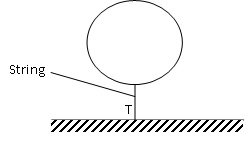Question
The figure below shows a balloon carrying hydrogen gas 3m3 of density 0.09kgm-3. The mass of the balloon fabric is 2kg and the density of air is 1.25kgm-3

i) Determine the tension in the string
ii) If the string is suddenly cut, calculate the acceleration of the balloon upwards
iii) What is the maximum mass of the equipment the balloon can lift at a constant velocity

i) Determine the tension in the string
ii) If the string is suddenly cut, calculate the acceleration of the balloon upwards
iii) What is the maximum mass of the equipment the balloon can lift at a constant velocity
Answer
i) Determine the tension in the string
The mass of the balloon fabric is 2kg and the density of air is 1.25kgm-3
mass of gas = 3X 0.9 kg kj = 0.27kg
Total weight of balloon
10 X (2+ 027) = 22.7
Mass of air displaced.
1.25 X 3 = 3.75
Wt of air displaced
1.25 X 3 = 3.75N
Tension = U - W
= 37.5N - 22.7 N= 14.8N
ii) If the string is suddenly cut, calculate the acceleration of the balloon upwards
F = M
14.8 = m ; where m = 2.27 kg
14.8 = 2.27
2.27 m/s2
iii) What is the maximum mass of the equipment the balloon can lift up at a constant velocity
10N/kg
14.8.N = 1.48kg
The mass of the balloon fabric is 2kg and the density of air is 1.25kgm-3
mass of gas = 3X 0.9 kg kj = 0.27kg
Total weight of balloon
10 X (2+ 027) = 22.7
Mass of air displaced.
1.25 X 3 = 3.75
Wt of air displaced
1.25 X 3 = 3.75N
Tension = U - W
= 37.5N - 22.7 N= 14.8N
ii) If the string is suddenly cut, calculate the acceleration of the balloon upwards
F = M
14.8 = m ; where m = 2.27 kg
14.8 = 2.27
2.27 m/s2
iii) What is the maximum mass of the equipment the balloon can lift up at a constant velocity
10N/kg
14.8.N = 1.48kg

